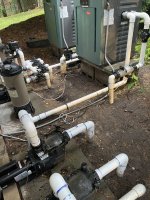I just inserted a trench drain behind pool house where the equipment is. It actually kept the area pretty dry as hurricane Henri hit (although Long Island got nowhere near the rain predicted).
So the general layout of pool house is dirt/grass around 3 sides and a stone patio in the front. The outside walls are stucco, which is problematic because the builder should not have had the stucco touching the ground (especially with pooling water). Contractor "solved" by installing a french drain around the perimeter (the three sides without the patio). And they put concrete block wall on outside surrounding the french drain, essentially creating a moat effect (the concrete block was needed because the grade of the grass was above the grade of the stucco, and would otherwise have filled over the french drain and abutted the stucco). The french drain is below the stucco, so if water gets to the french drain it will not touch the stucco and the stucco walls are protected. The problem is that water is blocked by the concrete block from getting into the french drain, and instead it seeps in below the french drain and penetrates the concrete block foundation to the poolhouse (the pool house crawl space is about 3 feet below the french drain).
The best solution would have been to lower the grade surrounding the pool house so the extra concrete block was not needed, but that would be a Herculean effort now (and the original contractor/builder is long gone after 20 years). So I now have 2 trench drains and one dry well on the three sides and am working to get new contractor to pitch the ground on each side to its respective drain. In the meantime, my new dehumidifier in the crawl space is keeping it very dry.
But I have an issue on the side with the stone patio. It is pitched for water to run off into the trench drain on one of the sides, but the water runs along the stucco to get there (see photo). I had to repair the stucco last year and I am unhappy with myself for not solving the problem then. You can already see green on the stucco forming at the bottom. I really dont know how to deal with this junction. There is wood abuting the patio under the glass doors, but the stucco goes virtually to the bottom on the remainder of this side of the house. There is maybe a 1/2 inch gap between the stucco and the foundation (the stucco does not quite touch the ground).
My question is what is the best way to protect the front side of my pool house from the water runoff on the patio? I am considering cutting the stone and putting in a french drain with crushed stones on top at the entrance. We had a channel drain there once until renovating 10 years ago, but it was ineffective in controlling the flow of water and a contractor removed it when we redid the stone and pitched the water to the side as a new "solution".
Photos below are (1) the front where the stone and stucco essentially abut (2) one of the sides with the French drain "moat" and (3) the trench drain in the rear where water used to pool around the pool equipment.




